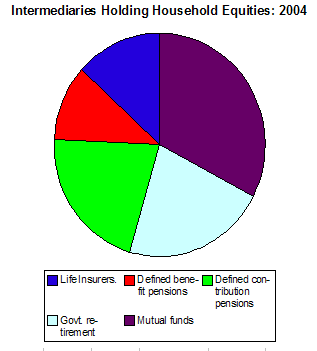Who’s Holding America’s Stock Proxies?
by John Schroy filed under Equities, Individual Investors
Over 55% of corporate stock that belongs to U.S. Households and Nonprofit Organizations is held indirectly through intermediaries who hold the power to vote these shares.
As of December 2004, according to the Federal Reserve Flow of Funds Account Table B100e, this indirect stock ownership was divided among five major categories of intermediaries, by market value:
- Life Insurance Companies: ($1,028.9 billion), as pension reserves, mainly individual and group annuities.
- Defined Benefit Private Pension Funds: ($859.9 billion), mainly corporate pension plans.
- Defined Contribution Pension Plans: ($1,656.3 billion), mainly 401(k) and similar company plans.
- State, Local, and Federal Government Retirement Funds: ($1,706.3 billion), mainly defined-benefit pension plans for state and local governments.
- Mutual Funds: ($2,531.6 billion), mainly as Individual Retirement Accounts.
The graphs shows how indirect holdings of equities belonging to Households and Nonprofit Organizations were divided among these categories of intermediaries in December 2004:
 Intermediaries Holding Stock Proxies
|
||


